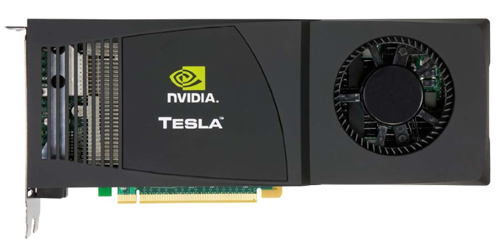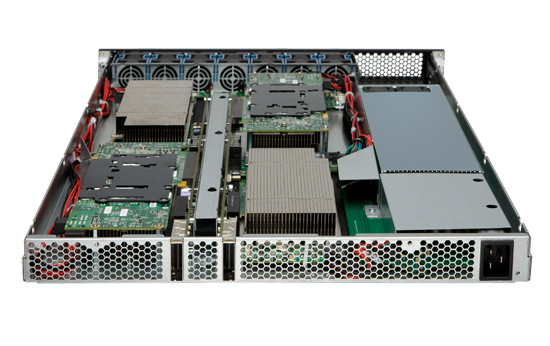NVIDIA's Fermi: Architected for Tesla, 3 Billion Transistors in 2010
by Anand Lal Shimpi on September 30, 2009 12:00 AM EST- Posted in
- GPUs
A Different Sort of Launch
Fermi will support DirectX 11 and NVIDIA believes it'll be faster than the Radeon HD 5870 in 3D games. With 3 billion transistors, it had better be. But that's the extent of what NVIDIA is willing to talk about with regards to Fermi as a gaming GPU. Sorry folks, today's launch is targeted entirely at Tesla.

A GeForce GTX 280 with 4GB of memory is the foundation for the Tesla C1060 cards
Tesla is NVIDIA's High Performance Computing (HPC) business. NVIDIA takes its consumer GPUs, equips them with a ton of memory, and sells them in personal or datacenter supercomputers called Tesla supercomputers or computing clusters. If you have an application that can run well on a GPU, the upside is tremendous.

Four of those C1060 cards in a 1U chassis make the Tesla S1070. PCIe connects the S1070 to the host server.
NVIDIA loves to cite examples of where algorithms ported to GPUs work so much better than CPUs. One such example is a seismic processing application that HESS found ran very well on NVIDIA GPUs. It migrated a cluster of 2000 servers to 32 Tesla S1070s, bringing total costs down from $8M to $400K, and total power from 1200kW down to 45kW.
| HESS Seismic Processing Example | Tesla | CPU |
| Performance | 1 | 1 |
| # of Machines | 32 Tesla S1070s | 2000 x86 servers |
| Total Cost | ~$400K | ~$8M |
| Total Power | 45kW | 1200kW |
Obviously this doesn't include the servers needed to drive the Teslas, but presumably that's not a significant cost. Either way the potential is there, it's just a matter of how many similar applications exist in the world.
According to NVIDIA, there are many more cases like this in the market. The table below shows what NVIDIA believes is the total available market in the next 18 months for these various HPC segments:
| Processor | Seismic | Supercomputing | Universities | Defence | Finance |
| GPU TAM | $300M | $200M | $150M | $250M | $230M |
These figures were calculated by looking at the algorithms used in each segment, the number of Hess-like Tesla installations that can be done, and the current budget for non-GPU based computing in those markets. If NVIDIA met its goals here, the Tesla business could be bigger than the GeForce one. There's just one problem:
As you'll soon see, many of the architectural features of Fermi are targeted specifically for Tesla markets. The same could be said about GT200, albeit to a lesser degree. Yet Tesla accounted for less than 1.3% of NVIDIA's total revenue last quarter.
Given these numbers it looks like NVIDIA is building GPUs for a world that doesn't exist. NVIDIA doesn't agree.
The Evolution of GPU Computing
When matched with the right algorithms and programming efforts, GPU computing can provide some real speedups. Much of Fermi's architecture is designed to improve performance in these HPC and other GPU compute applications.
Ever since G80, NVIDIA has been on this path to bring GPU computing to reality. I rarely get the opportunity to get a non-marketing answer out of NVIDIA, but in talking to Jonah Alben (VP of GPU Engineering) I had an unusually frank discussion.
From the outside, G80 looks to be a GPU architected for compute. Internally, NVIDIA viewed it as an opportunistic way to enable more general purpose computing on its GPUs. The transition to a unified shader architecture gave NVIDIA the chance to, relatively easily, turn G80 into more than just a GPU. NVIDIA viewed GPU computing as a future strength for the company, so G80 led a dual life. Awesome graphics chip by day, the foundation for CUDA by night.
Remember that G80 was hashed out back in 2002 - 2003. NVIDIA had some ideas of where it wanted to take GPU computing, but it wasn't until G80 hit that customers started providing feedback that ultimately shaped the way GT200 and Fermi turned out.
One key example was support for double precision floating point. The feature wasn't added until GT200 and even then, it was only added based on computing customer feedback from G80. Fermi kicks double precision performance up another notch as it now executes FP64 ops at half of its FP32 rate (more on this later).
While G80 and GT200 were still primarily graphics chips, NVIDIA views Fermi as a processor that makes compute just as serious as graphics. NVIDIA believes it's on a different course, at least for the short term, than AMD. And you'll see this in many of the architectural features of Fermi.










415 Comments
View All Comments
Fortesting - Wednesday, October 7, 2009 - link
See this article:http://www.semiaccurate.com/2009/10/06/nvidia-kill...">http://www.semiaccurate.com/2009/10/06/...x260-aba...
Zool - Tuesday, October 6, 2009 - link
Maybe tesla cards in supercomputers which are closed platforms the cuda is better but for anything other commercial OpenCL will be better.This is a CUDA vs OpenCL test from Sisoftware http://www.sisoftware.net/index.html?dir=qa&lo...">http://www.sisoftware.net/index.html?di...ocation=...
The conclusion from that article : We see little reason to use proprietary frameworks like CUDA or STREAM once public drivers supporting OpenCL are released - unless there are features your code depends on that are not included yet; even then, they will most likely be available as extensions (similar to OpenGL) pretty soon.
It wouldnt be bad to see those kind of tests on anadtech. Something like GPUs vs CPUs tests with same code.
Zool - Monday, October 5, 2009 - link
I dont know how others, but the 8 time increase in DP which is one of the pr stunts doesnt seem too much if u dont compare it to the weak gt200 DP numbers. The 5870 has something over 500 GFlops DP and the gt200 had around 80 GFlops DP (but the quadro and tesla cards had higher shader clocks i think). They will be happy if they reach 1.5 times the radeon 5800 DP performance. In this pdf from nvidia site http://www.nvidia.com/content/PDF/fermi_white_pape...">http://www.nvidia.com/content/PDF/fermi...T.Halfhi... they write that the ECC will hawe a performance penalty from 5% to 20% (on tesla cards u will hawe the option to turn it off/on on GT cards it will be turned off).Zool - Monday, October 5, 2009 - link
I also want to add that if the DP has increased 8 times from gt200 than let we say around 650 Gflops, than if the DP is half of the SP (as they state) performance in Fermi than i get 1300 Gflops ???? (with same clock speeds). For GT200 they stated 933 Gflops. Something is wrong here maybe ?Zool - Monday, October 5, 2009 - link
Actualy they state 30 FMA ops per clock for 240 cuda cores in gt200 and 256 FMA ops per clock for 512 cuda cores in Fermi. Which means clock for clock and core for core they increased 4 times the DP performance.SymphonyX7 - Saturday, October 3, 2009 - link
Hi. I'm a long time Anandtech reader (roughly 4 years already). I registered yesterday just because I wanted to give SiliconDoc a piece of my mind but thankfully ended being up being rational and not replying anymore.Now that he's gone. I just want to know what you guys think of Fermi being another big chip. Is it safe to assume that Nvidia is losing more money than ATI on high-end models being sold simply because the GTX cards are much bigger than their ATI counterparts? Moreso now that the HD 58xx cards have been released which are faster overall than any of Nvidia's single-GPU solutions. Nvidia will be forced to further lower the price of their GTX cards. I'm still boggled as to why Nvidia would still cling to really big chips rather than go ATI's "efficiency" route. From what I'm reading, this card may focus more on professional applications rather than raw performance in games. Is it possible that this may simply be a technology demonstrator in the making in addition to something that will "reassure" the market to prevent them from going ATI? I don't know why they should differentiate this much if it's intended to compete with ATI's offerings, unless that isn't entirely their intention...
Nakomis - Saturday, October 3, 2009 - link
Boy can I tell you I really wish SilDoc was still here? Anyone have his email address? I wanted to send him this:http://rss.slashdot.org/~r/Slashdot/slashdot/~3/9J...">http://rss.slashdot.org/~r/Slashdot/sla...es-Fermi...
- Saturday, October 3, 2009 - link
There was no benchmark, not even a demo during the so-called demonstration! This is very pathetic and it looks that Nvidia wont even meet the december timeframe. To debug a chip that doesnt work properly might cost many months. To manufacture a chip another 12 weeks. To develop the infrastructure including drivers and card manufactures another few months. Therefore, late q12010 or even 6/2010 might become realistic for a true launch and not a paperlaunch. What we could see on this demonstration was no more than the paper launch of the paper launch.Nate0007 - Friday, October 9, 2009 - link
Hi, I fully agree with you 100%You seem to be one of very FEW people that actually see that or get it.
You know what i can not seem to understand ??
How can supposedly a few hundred or so of people that are knowlegable of what it is they are about too see or somewhat of why they are attending the demonstration just sit there and listen to 1 person standing up and make claims about his or a product but have no proof ?
I understand how things are suppose to be, but have we all just become so naive to just believe what is pushed onto us through media ( ie..TV,Radio.Blogs.Magazines.ect...) and just believe it all ?
I am not saying that what Jen Shun showed was NOT a real demo of a working Fermi Card , I am just saying that there was and still is NO proof of any sort from anyone that was able to actually confirm or denie that it actually was.
Untill Nvidia actually shows a working sample of Fermi , even a so called ruffor demo model of it so long as it actually real I will not believe it.
There is a huge difference between someone makeing claims on the forums of sites like this here and or Blogs and someone who is holding a news conference clainming what they have achieved .
Next thing you know someone will stand up and say they have discoverd how to time travel and then show a video of just that.
There is a difference be facts and reality.
bigboxes - Saturday, October 3, 2009 - link
RED ROOSTER! jk :pFWIW, I'm glad AT banned that fool. Too bad it took 37 pages of fanboi ranting for it to come to fruition. For those that cry that there is no place to discuss this AT does have a video forum that will not allow this kind of shenanigans. Does anyone wonder if this is Rollo back from the grave?